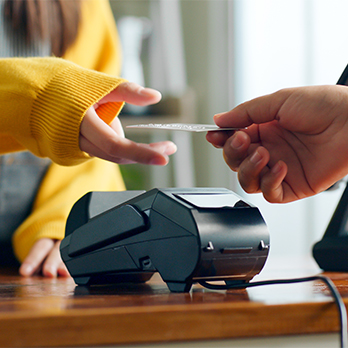Get the flexible funding you need, when you need it.
Learn More about Home Equity Lines of Credit (HELOCs)Security & Fraud
Identity Theft
As your local financial partner, the safety and security of your personal and financial information is our top priority. Our fraud prevention services are in place to keep you safe from identity theft, online phishing scams, and more. So you can feel safe and secure knowing not only how to keep yourself safe from online scammers, but that you have a secure financial partner to give you added protection to help safeguard your identity.
Additional Resources for Your Protection:
Be Aware of Phishing Scams
What is Phishing?
Phishing, pronounced just like “fishing,” is a common online scam in which scammers are “fishing” for your personal and financial info. They are after important information like account numbers, passwords, Social Security numbers, and other confidential details that they can use to empty your bank account or max out your credit cards.
Who can become a victim of a phishing scam? Anyone. These phishing con artists can use the sensitive info they get their hands on to take out loans, open credit cards, and even get driver’s licenses in your name. They can wreak havoc on your financial record and personal reputation that could take years to untangle. That’s why, at Altoona First Savings Bank, we give you the tools and resources you need to protect yourself against these phishing scams by showing you how they work and giving you steps to protect yourself from cyber crime.
How Phishing Works
In a typical case, you’ll receive an email that appears to come from a reputable company that you recognize and do business with, such as your financial institution. In some cases, the email may appear to come from a government agency, including one of the federal financial institution regulatory agencies.
The email may warn you of a serious problem that requires your immediate attention. It may use phrases, such as “Immediate attention required,” or “Please contact us immediately about your account.” The email will then encourage you to click on a button to go to the institution’s web site. In a phishing scam, you could be redirected to a phony web site that may look exactly like the real thing. Sometimes, in fact, it may be the company’s actual web site. In those cases, a pop-up window will quickly appear for the purpose of harvesting your financial information.
In either case, you may be asked to update your account information or to provide information for verification purposes: your Social Security number, your account number, your password, or the information you use to verify your identity when speaking to a real financial institution, such as your mother’s maiden name or your place of birth. Warning: If you provide the requested information, you may find yourself the victim of identity theft.
How to Protect Yourself
Never provide your personal information in response to an unsolicited request, whether it is over the phone or over the Internet or even a fax or letter. Emails and Internet pages created by phishers may look exactly like the real thing. They may even have a fake padlock icon that ordinarily is used to denote a secure site. (It’s important to keep anti-virus and anti-spam filtering software up-to-date on your computer.) If you did not initiate the communication, you should not provide any information.
If you believe the contact may be legitimate, contact the financial institution yourself. You can find phone numbers and web sites on the monthly statements you receive from your financial institution, or you can look the company up in a phone book or on the Internet. The key is that you should be the one to initiate the contact, using contact information that you have verified yourself.
Never provide your password over the phone or in response to an unsolicited Internet request. A financial institution would never ask you to verify your account information online. Thieves armed with this information and your account number can help themselves to your savings. (It is a good idea to periodically change your passwords and PIN numbers to improve security.)
Review account statements regularly to ensure all charges are correct. If your account statement is late in arriving, call your financial institution to find out why. If your financial institution offers electronic account access, periodically review activity online to catch suspicious activity.
Report suspicious emails or calls to the Federal Trade Commission through the Internet at www.consumer.gov/idtheft, or by calling 1-877-IDTHEFT.
A message from the federal bank, thrift, and credit union regulatory agencies:
- Board of Governors of the Federal Reserve System
- Federal Deposit Insurance Corporation
- National Credit Union Administration
- Office of the Comptroller of the Currency
- Office of Thrift Supervision
Counterfeit Check Scams
Don’t Fall Victim
Counterfeit or fake checks are being used in a growing number of fraudulent schemes, including foreign lottery scams, check overpayment scams, Internet auction scams, and secret shopper scams. These fakes come in many forms, from cashier’s checks and money orders to corporate and personal checks. Could you be a victim? Not if you know how to recognize and report them.
View this PDF on counterfeit check scams to learn more.




